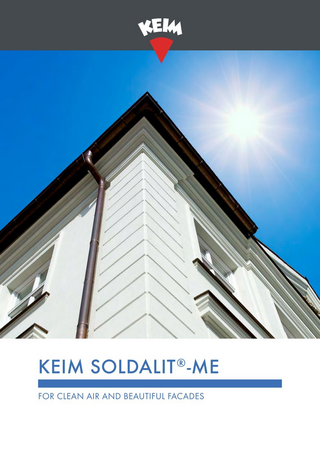Photocatalysis - paints with added value
For the protection of your facade and the environment.
Our standard of living today typically involves heavy traffic, industrial mass production and the consumption of massive amounts of energy – and it is precisely these factors that are the main sources for air pollution. Traffic is a major contributor to this. Car engines pollute our air with nitrogen oxides, carbon monoxide, sulphur dioxide and particulate matter.
Using the power of the sun
In a similar way to how photosynthesis works in plants, photocatalysis is an active process which is also initiated by light. Whilst photosynthesis uses sunlight to produce a substance (glucose), photocatalysis breaks down or converts substances. The term photocatalysis describes a principle of action in which a substance (= "catalyst") is stimulated by light (= "photo") to trigger or accelerate a chemical reaction without consuming itself in the process.
In principle, photocatalysis can also be used in building materials. The active photocatalytic pigment (= catalyst) can even break down things like harmful gases. This process converts the gases into small, harmless components.
Photocatalysing in paints
Research and Development departments at leading paint manufacturers have been working for an extended time on the challenge of using photocatalysis in paints. One characteristic of the photocatalytic reaction is that it attacks organic substances, including organic components in the binders of conventional paint systems. This means that the photocatalytic process virtually destroys the paint itself as it breaks down the binding agents in the surface. The consequences are chalking and premature weathering, with a corresponding shorter life expectancy for the paint. It reacts differently to inorganic, silicate binding agents. This is because the binder is not attacked by the photocatalytic reaction.
With KEIM Soldalit-ME we succeeded in engineering a long-lasting coating with enhanced self-cleaning properties by combining a photocatalytic pigment with a mineral binder system.
Photoactive, mineral paints provide a true added value compared to common organically bound paint materials (e.g. dispersion or silicone resin paints.):
Inorganic, silicate binding agents are ideal for effective and long-lasting photocatalytic coatings.
What is photocatalysis?
This video explains perfectly the process of photocatalysis (only available in German language!)
Clean facades
A photocatalytically active, silicate facade paint becomes hydrophilic under the influence of light.
The high soiling resistance of photocatalytic mineral paints is attributed to three main features.
Effect 1: Self-cleaning effect
A hydrophilic surface supports self-cleaning of facade surfaces when they are wetted by rain or moisture. A photocatalytic silicate facade paint becomes hydrophilic under the influence of light. The coating reduces the surface tension of the water, which makes it easier to wash away dirt.
Effect 2: Fast drying speed
Water spreads out like a thin film over the surface. The spreading enlarges the evaporation surface and thus makes the drying speed higher than a hydrophobic coating. The drying process is clearly faster on the extremely large and specific surface of a microporous silicate coating (compared to a conventional dispersion coating). And drier surfaces do not provide good conditions for algae and fungi growth.
Effect 3: Anti-static and non-thermoplastic
Silicate coatings are anti-static and non-thermoplastic. So dirt particles do not adhere very well to the surface.
Clean air
Photocatalytically active mineral coatings help to break down air pollutants. Photocatalytic mineral paints in exterior spaces contribute to the decomposition of atmospheric air pollutants such as nitrogen oxides, greenhouse gases and superficial contaminations. By doing this, the durability of the inorganically bound coating is not reduced.
Photoactive coatings decompose many other pollutants in addition to nitrogen oxides, for example sulphur dioxide (SO2), ammonia (NH3), carbon monoxide (CO), solvents, formaldehyde or even fats and acids.


